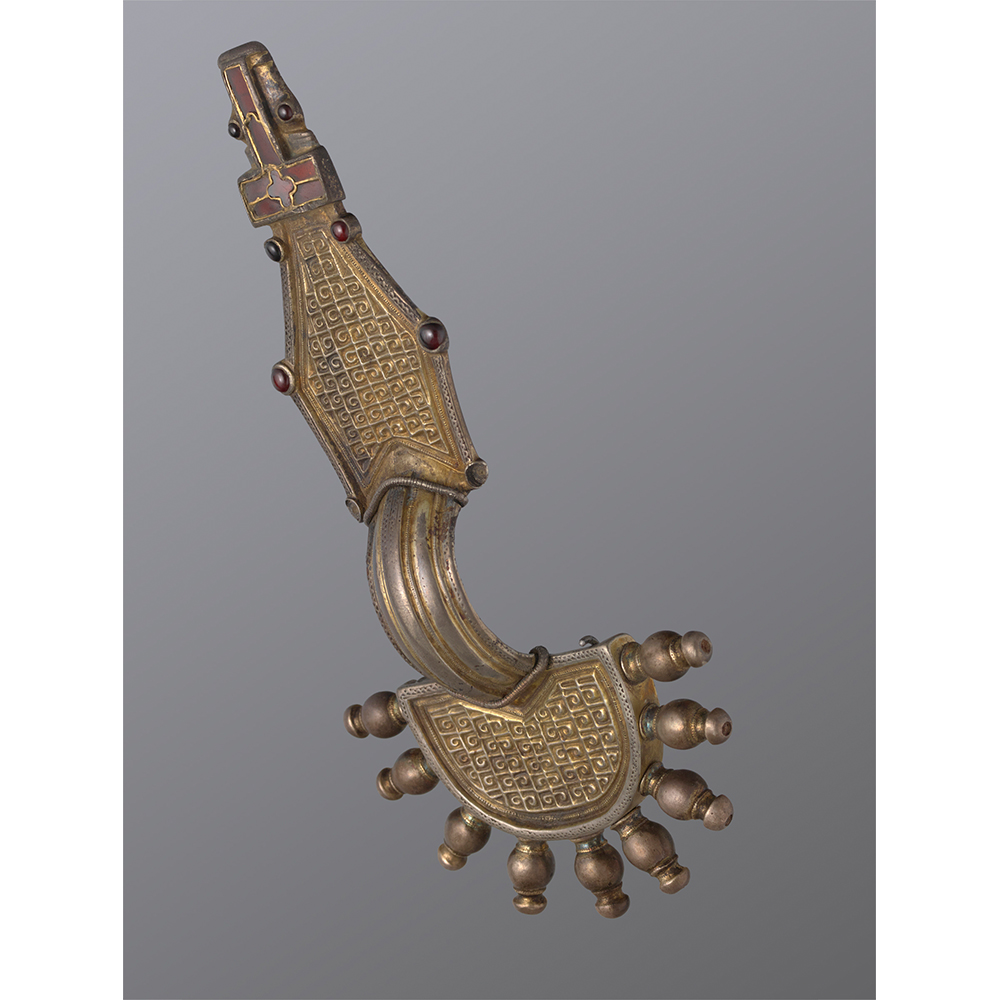Frankish Animal Head Bow Brooch (Fibula)

Partially gilt silver, garnet
Length: 7.9 in (20.2 cm)
Wyvern Collection, 1025
From the late-fifth to the mid-seventh centuries, much of north-western Europe was ruled by the Merovingian dynasty.Our knowledge of this Frankish culture is largely derived from jewelry, vessels, and weaponry buried with the dead. This bow fibula, a type of brooch developed in the Bronze Age, likely would have been worn by a sixth-century Merovingian woman. The richness of this object’s complex patterning and inlaid garnet signified the woman’s elevated social status. Like many similar items surviving from early medieval Europe, the original context of this piece is undocumented, but many examples have been discovered at burial sites. Evidence from late fifth- and sixth-century Merovingian burial mounds suggest that two heavy brooches, similar to this bow fibula, were worn at the waist, as many have been discovered near the pelvises of skeletons. However, since the popular tunica garment was sewn shut along the sides, these brooches served a decorative purpose rather than a functional one. (1) This is further reinforced by the fact that, beginning in approximately 450 CE, bow brooches were made primarily out of precious metals such as silver and gold, rather than sturdier materials like copper alloy or iron.
This type of sixth-century bow brooch was traditionally constructed with a semi-circular “headplate” adorned with radiating knobs, a diamond-shaped “footplate”, and a semi-circular bow connecting the two. (2) On the reverse side of the brooch there would have been a pin and clasp, although these no longer remain on the Wyvern Bow Fibula. This footplate is similar to the one on the Pincer Brooch in the Morgan Library and Museum in New York. (3) Both brooches narrow to resemble the head of a vaguely serpentine animal with a horizontal brow intersecting with a thick vertical line which symmetrically divides the face. Instead of the zigzag decoration seen on the Pincer Brooch and other examples, the plates of the Wyvern Bow Fibula are ornamented with columns of c-shaped curls, half of which face inward to the right, while the other half face inward to the left. Each curl is individually outlined by a square, creating a strong sense of order and balance through texturing. This patterning could be interpreted as scales, further illuminating the animal form of this lavish object.
The brooch’s opulence is also conveyed through the striking presence and symbolism of garnet, a gemstone long prized for its alleged celestial power, representing love and life in both the earthly and spiritual realms in the late Roman period. (4) The Merovingian dynasty arose to fill the power vacuum emerging out of the gradual collapse of the western Roman Empire, so the garnet might suggest that its owner possessed an impressive awareness of Roman tradition. Alternatively, as Christianity had reached portions of the Merovingian empire, the deep red hue of this gemstone could have been intended to represent the blood of Christ, reflecting the piety and scriptural familiarity of a Christian owner. Given the limited knowledge acquired from excavations of Merovingian graves, both interpretations of the stone’s meaning are plausible as the belief system of the object’s owner remains unknown. The brooch itself contributes to this uncertainty as the garnet decoration of the animal’s brow presents a contemplative ambiguity: is it a floral motif, the Christian cross, or both?
Brooke Wrubel, Class of 2021
Notes
- Webster and Brown 1997, p. 156; Martin 2000, p. 226.
- This common terminology is misleading, as burial contexts suggest that many such brooches were worn with the wider end pointing down and the narrower end pointing up, in relation to the wearer’s body.
- New York, The Morgan Library and Museum, 2012.2:101; see Adams 2014, p. 178.
- Arrhenius 2000, p. 214.